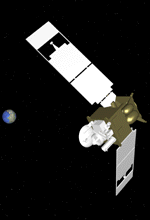![]()
![]()
 |
Engineers working on Surveyor's flight operations team refer to the 750 million kilometer (466 million mile) journey from Earth to Mars as the "cruise" phase of the mission. During this time period, Surveyor will coast around the Sun in an orbit that will intercept Mars 10 months after launch. The flight team will conduct few operations in cruise other than monitoring the spacecraft to ensure that all systems function normally, and sending commands that will refine Surveyor's flight path to Mars.
Course Corrections. These minor changes in the spacecraft's flight path are called trajectory correction maneuvers (TCMs). Each correction will involve a short firing of Surveyor's rocket engine to gently change the spacecraft's speed and direction of travel.
The first of four scheduled TCMs occurred 14 days after launch and adjusted the spacecraft's velocity by about 27 meters per second (56 miles per hour). This maneuver corrected most of the velocity errors accumulated during the launch. Although the Delta's computer control systems are extremely accurate, the rocket's powerful engines lack the finesse needed to push the spacecraft to an exact velocity.
According to the flight plan, the remaining TCMs will occur in March, April, and late August 1997. All of the final three correction maneuvers will involve a velocity change much smaller than the first. Consequently, the calculations from Surveyor's navigation team will require extreme precision. The reason is that a velocity error as small as one meter per second (2.2 miles per hour) may result in missing Mars by thousands of kilometers after a 10-month journey.
The combination of the four TCMs will allow the navigation team to aim the spacecraft for a point barely 300 kilometers (186 miles) in front of Mars. Achieving this accuracy after a 750- million-kilometer journey is equivalent to throwing a baseball from San Francisco to New York and hitting the torch on the Statue of Liberty.